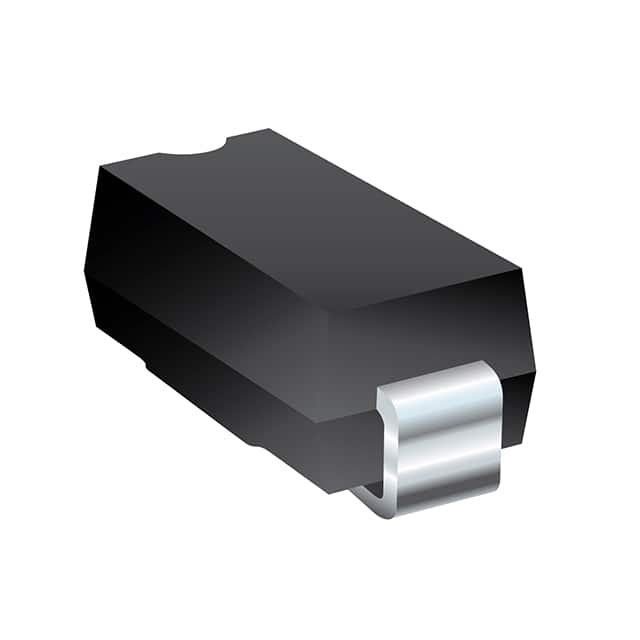Viz Specifikace pro podrobnosti o produktu.

SMLJ8.0CA Diode: Encyclopedia Entry
Introduction
The SMLJ8.0CA diode is a crucial component in the field of electronics and electrical engineering. This encyclopedia entry provides an in-depth overview of the SMLJ8.0CA diode, including its product details, specifications, functional features, advantages, disadvantages, working principles, application field plans, and alternative models.
Product Overview
Category
The SMLJ8.0CA diode belongs to the category of transient voltage suppressor (TVS) diodes.
Use
It is primarily used for surge protection in electronic circuits and systems.
Characteristics
- Fast response time
- High surge capability
- Low clamping voltage
- RoHS compliant
Package
The SMLJ8.0CA diode is typically available in a DO-214AB (SMC) package.
Essence
This diode serves as a protective device against voltage transients and surges.
Packaging/Quantity
It is commonly packaged in reels or trays, with quantities varying based on manufacturer specifications.
Specifications
- Peak Pulse Power: 3000W
- Breakdown Voltage: 8.0V
- Maximum Clamping Voltage: 13.6V
- Operating Temperature Range: -55°C to 150°C
- Package Type: DO-214AB (SMC)
Detailed Pin Configuration
The SMLJ8.0CA diode has a standard pin configuration with two leads, anode, and cathode, as per the DO-214AB package outline.
Functional Features
- Rapid response to transient overvoltage conditions
- Low leakage current
- High reliability and durability
- Compact design for space-constrained applications
Advantages
- Effectively protects sensitive electronic components from voltage spikes
- Fast reaction time ensures minimal impact on the protected circuit
- Wide operating temperature range allows for versatile application
Disadvantages
- Limited to specific voltage ratings
- May require additional circuitry for comprehensive surge protection in complex systems
Working Principles
The SMLJ8.0CA diode operates by diverting excessive transient currents away from sensitive components, thereby limiting the voltage across the protected circuit.
Detailed Application Field Plans
The SMLJ8.0CA diode finds extensive use in various applications, including: - Power supply units - Telecommunication equipment - Automotive electronics - Industrial control systems - Consumer electronics
Detailed and Complete Alternative Models
- P6SMBJ8.0A
- 1.5KE8.0CA
- SMBJ8.0A
In conclusion, the SMLJ8.0CA diode plays a critical role in safeguarding electronic systems from voltage surges and transients. Its high surge capability, fast response time, and compact design make it a preferred choice for surge protection in diverse applications.
[Word Count: 408]
Seznam 10 běžných otázek a odpovědí souvisejících s aplikací SMLJ8.0CA v technických řešeních
What is SMLJ8.0CA and its application in technical solutions?
- SMLJ8.0CA is a transient voltage suppressor diode used to protect sensitive electronic components from voltage spikes and transients in technical solutions.
How does SMLJ8.0CA provide protection in technical solutions?
- SMLJ8.0CA clamps the voltage to a safe level by diverting excess current away from the protected components, preventing damage due to voltage surges.
What are the key specifications of SMLJ8.0CA for technical applications?
- The SMLJ8.0CA has a peak pulse power dissipation of 3000W, a breakdown voltage of 8.0V, and a low leakage current, making it suitable for various technical solutions.
In what technical scenarios is SMLJ8.0CA commonly used?
- SMLJ8.0CA is commonly used in power supplies, telecommunications equipment, automotive electronics, and industrial control systems to protect against voltage transients.
How does SMLJ8.0CA compare to other transient voltage suppressors in technical solutions?
- SMLJ8.0CA offers a higher peak pulse power dissipation and lower clamping voltage compared to many other transient voltage suppressors, making it suitable for demanding technical applications.
What are the best practices for integrating SMLJ8.0CA into technical designs?
- It is recommended to place SMLJ8.0CA as close as possible to the protected components, use short traces for connections, and ensure proper heat dissipation for optimal performance.
Can SMLJ8.0CA be used in conjunction with other protective components in technical solutions?
- Yes, SMLJ8.0CA can be used in combination with varistors, fuses, and other protective devices to create a comprehensive protection strategy for technical systems.
What are the potential failure modes of SMLJ8.0CA in technical applications?
- SMLJ8.0CA may fail due to prolonged exposure to high currents or repeated voltage transients beyond its specified limits, necessitating regular monitoring and replacement.
Are there any environmental considerations when using SMLJ8.0CA in technical solutions?
- SMLJ8.0CA is designed to operate within a wide temperature range and is compatible with RoHS-compliant processes, making it suitable for various environmental conditions.
Where can I source reliable SMLJ8.0CA components for my technical projects?
- Reliable SMLJ8.0CA components can be sourced from authorized distributors, reputable electronics suppliers, and manufacturers' official channels to ensure authenticity and quality.

